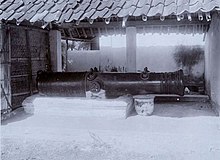
Ki Amuk is an ancient cannon belonging to the Sultanate of Banten, which is currently located in front of the Grand Mosque of Banten, Banten Province, Indonesia. Ki Amuk cannon was used to protect the Karanghantu Port in Banten Bay.
Legend and history
[edit]According to legend, Ki Amuk was the incarnation of the cursed Sultanate of Demak soldier. But according to the historical sources, this cannon was made in Central Java in the 16th century around 1527 A.D., which was later presented to Sultan Hasanuddin of the Sultanate of Banten by Sultan Trenggono, originally named Ki Jimat. Si Jagur cannon in the Jakarta Fatahillah Museum yard is the "twin" of Ki Amuk.[1]
Description
[edit]The Ki Amuk cannon is made of bronze weighing 7 tons, with the length of 3 m (9.8 ft), the largest outer diameter is 0.70 m (2 ft 4 in), the inside diameter of the mouth is 0.34 m (1 ft 1 in). It fired a cannonball weighing 180 lb (82 kg).[2]
The Majapahit Sun symbol can be seen in its muzzle. There are two Arabic inscriptions on this cannon. The first reads "Aqibah al-Khairi Salamah al-Imani" which means "The fruit of all good is the perfection of faith". The second inscription reads "La fata illa Ali la saifa illa Zu al-faqar, isbir ala ahwaliha la mauta" which means "There is no victor except Ali, there is no sword but Zulfiqar, thou shalt fear God (taqwa) all the time until death".[1]
See also
[edit]References
[edit]- ^ a b "Legenda Meriam Ki Amuk, Jelmaan Prajurit Demak yang Dikutuk". SINDOnews.com (in Indonesian). Retrieved 2020-03-16.
- ^ Crucq, K. C. 1938a. 'De Geschiedenis van het Heilig Kanon te Banten', TBG, LXXVIII/3: 339-91.1941.
External links
[edit]Legend of Ki Amuk



Well, that’s interesting to know that Psilotum nudum are known as whisk ferns. Psilotum nudum is the commoner species of the two. While the P. flaccidum is a rare species and is found in the tropical islands. Both the species are usually epiphytic in habit and grow upon tree ferns. These species may also be terrestrial and grow in humus or in the crevices of the rocks.
View the detailed Guide of Psilotum nudum: Detailed Study Of Psilotum Nudum (Whisk Fern), Classification, Anatomy, Reproduction